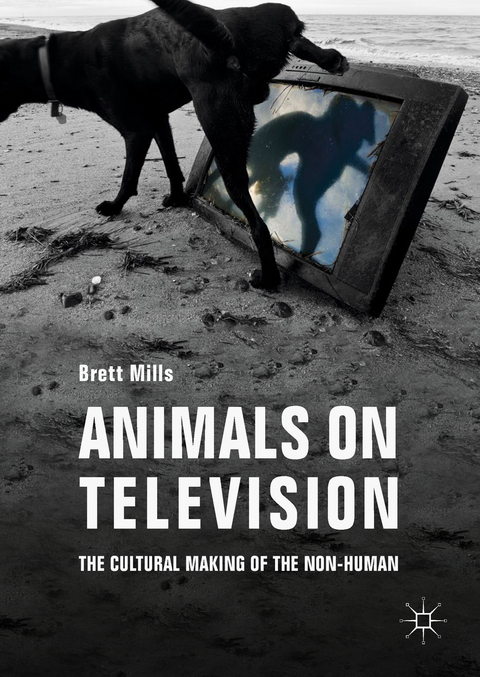
Animals on Television
Palgrave Macmillan (Verlag)
978-1-137-51682-4 (ISBN)
This book is the first in-depth study of the representation of animals on television. It explores the variety of ways animals are represented in audio-visual media, including wildlife documentaries and children’s animated series, and the consequences these representations have for those species. Brett Mills discusses key ideas and approaches essential for thinking about animals drawing on relevant debates in philosophy, politics, gender studies, humanism and posthumanism, and ethics. The chapters examine different animal representations, focusing on zoos, pets, wildlife and meat. They present case studies, including discussions of Peppa Pig, The Hunt and The Dog Whisperer. This book will be of interest to readers exploring media studies, contemporary television, animal studies, and debates about representation.
Brett Mills is Senior Lecturer in Television Studies at the University of East Anglia, UK. His work on animals in media has been published in Screen, Continuum, Critical Studies in Television, European Journal of Cultural Studies, Environmental Communication and Journal of Literary and Cultural Disability Studies. He has been profiled in the Journal of Wild Culture.
1.0 Introduction: Dumb.- 1.1 i. They’re Out There.- 1.2 ii. Four Dogs.- 1.3 iii. Noticing Animals.- 1.4 iv. The Animal Turn.- 1.5 v. Dumb.- 1.6 vi. Television and the Public.- 1.7 vii. Unseen/Unheard/Unsmelled….- 2.0 Human.- 2.1 i. Alien/Human.- 2.2 ii. The Species Problem.- 2.3 iii. The Dominance of Science.- 2.4 iv. The Humanities and Humanism.- 2.5 v. Posthumanism.- 2.6 vi. Case Study: Peppa Pig.- 3.0 Wild.- 3.1 i. The Best TV Series Ever.- 3.2 ii. Documentary.- 3.3 iii. The Social Construction of Nature.- 3.5 iv. The Anthropocene.- 3.5 v. The Anthroposcene.- 3.6 vi. Case Study: The Hunt.- 4.0 Zoo.- 4.1 i. Standard Practice.- 4.2 ii. An Unnatural History.- 4.3 iii. To Be Seen.- 4.4 iv. For Their Own Good.- 4.5 v. Case Study: Our Zoo.- 5.0 Pet.- 5.1 i. In the Home.- 5.2 ii. Animal Ownership.- 5.3 iii. Animal Labour.- 5.4 iv. Dominance and Affection.- 5.5 v. Case Study: Dog Whisperer with Cesar Millan.- 5.0 Chapter 5: Meat.- 5.1 i. A Chilling Artefact.- 5.2 ii. Making Meat.- 5.3 iii. Cooking Meat.- 5.4 iv. Case Study: Jamie and Jimmy’s Friday Night Feast<.- 6.0 Conclusion: Undumb.- 6.1 i. DogTV.- 6.2 ii. Species.- 6.3 iii. Subjectivity.- 6.4 iv. Looking.- 6.5 v. Seeing.- 6.6 vi. Television.- 6.7 vii. Animalities.
“Mills’s book has much to offer those interested in rethinking animal representation and human–animal relationships. The breadth of his scholarly engagement is particularly impressive: Mills brings together work from fields such as the sciences, ethics, disability studies and philosophy, along with frameworks from film and television studies. His ability, both to make complex ideas accessible to non-specialists … and to demonstrate how disparate disciplines effectively ask the same sets of questions, offers a model for the kind of interdisciplinary scholarship to which many of us aspire.” (Zoë Shacklock, Critical Studies in Television, Vol. 14 (3), September, 2019)
| Erscheinungsdatum | 22.11.2017 |
|---|---|
| Zusatzinfo | VIII, 279 p. |
| Verlagsort | Basingstoke |
| Sprache | englisch |
| Maße | 148 x 210 mm |
| Themenwelt | Kunst / Musik / Theater ► Film / TV |
| Kunst / Musik / Theater ► Fotokunst | |
| Geisteswissenschaften ► Philosophie ► Ethik | |
| Sozialwissenschaften ► Kommunikation / Medien | |
| Schlagworte | animal documentary • animals • animals on TV • Animal Studies • Animal television programmes • Anthropocentrism • dumb animals • meat on screen • Peppa Pig • posthumanism • representation of animals • Television • The Dog Whisperer |
| ISBN-10 | 1-137-51682-8 / 1137516828 |
| ISBN-13 | 978-1-137-51682-4 / 9781137516824 |
| Zustand | Neuware |
| Haben Sie eine Frage zum Produkt? |
aus dem Bereich


